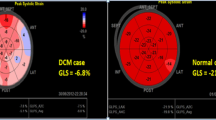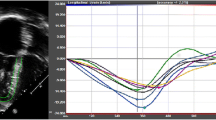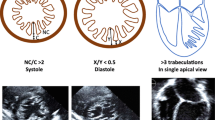Abstract
Restrictive cardiomyopathy (RCM) is characterized by irreversible diastolic dysfunction with preserved systolic function. The aim of this study was to investigate the presence of impaired ventricular contractility even in the presence of normal ejection fraction (EF) in children with RCM. Longitudinal Doppler tissue velocities were obtained from apical 4-chamber view at three locations—the left-ventricular (LV) lateral wall, the septum, and the right ventricle—in 8 children age 3–17 years old with RCM who had LV EF >55%. Peak systolic velocity (S′), acceleration during isovolumic contraction (IVA), and myocardial performance index (MPI) were measured. Data from the RCM group were compared with those from 24 age- and sex-matched controls. Both S′ and IVA were markedly lower at the septum (S′ 6.2 ± 1.7 vs. 9.2 ± 1.6, P < 0.001; IVA 1.8 ± 0.5 vs. 3.9 ± 1.5, P < 0.001). MPI, a measure of both diastolic and systolic function, was statistically significantly greater in the RCM group at all 3 locations (P < 0.005). S′ and IVA identify global subclinical systolic dysfunction in RCM with normal EF. These findings suggest that pre-ejection abnormality and subclinical systolic dysfunction coexist with diastolic dysfunction in children with RCM.





Similar content being viewed by others
References
Bach DS (1996) Quantitative Doppler tissue imaging as a correlate of left ventricular contractility. Int J Card Imaging 12:191–195
Bruch C, Gradaus R, Gunia S, Breithardt G, Wichter T (2003) Doppler tissue analysis of mitral annular velocities: evidence for systolic abnormalities in patients with diastolic heart failure. J Am Soc Echocardiogr 16:1031–1036
Denfield SW (2002) Sudden death in children with restrictive cardiomyopathy. Cardiol Electrophysiol Rev 6:163–167
Eidem BW, McMahon CJ, Cohen RR, Wu J, Finkelshteyn I, Kovalchin JP et al (2004) Impact of cardiac growth on Doppler tissue imaging velocities: a study in healthy children. J Am Soc Echocardiogr 17:212–221
Lewis AB (1992) Clinical profile and outcome of restrictive cardiomyopathy in children. Am Heart J 123:1589–1593
Lipshultz SE, Sleeper LA, Towbin JA, Lowe AM, Orav EJ, Cox GF et al (2003) The incidence of pediatric cardiomyopathy in two regions of the United States. N Engl J Med 348:1647–1655
Lytrivi ID, Lai WW, Ko HH, Nielsen JC, Parness IA, Srivastava S (2005) Color Doppler tissue imaging for evaluation of right ventricular systolic function in patients with congenital heart disease. J Am Soc Echocardiogr 18:1099–1104
Meluzin J, Spinarova L, Hude P, Krejci J, Kincl V, Panoversusky R et al (2005) Prognostic importance of various echocardiographic right ventricular functional parameters in patients with symptomatic heart failure. J Am Soc Echocardiogr 18:435–444
Mishiro Y, Oki T, Yamada H, Wakatsuki T, Ito S (1999) Evaluation of left ventricular contraction abnormalities in patients with dilated cardiomyopathy with the use of pulsed tissue Doppler imaging. J Am Soc Echocardiogr 12:913–920
Rivenes SM, Kearney DL, Smith EO, Towbin JA, Denfield SW (2000) Sudden death and cardiovascular collapse in children with restrictive cardiomyopathy. Circulation 102:876–882
Tei C (1995) New non-invasive index for combined systolic and diastolic ventricular function. J Cardiol 26:135–136
Vogel M, Cheung MM, Li J, Kristiansen SB, Schmidt MR, White PA et al (2003) Noninvasive assessment of left ventricular force-frequency relationships using tissue Doppler-derived isovolumic acceleration: validation in an animal model. Circulation 107:1647–1652
Vonk MC, Sander MH, van den Hoogen FH, van Riel PL, Verheugt FW, van Dijk AP (2007) Right ventricle Tei-index: a tool to increase the accuracy of non-invasive detection of pulmonary arterial hypertension in connective tissue diseases. Eur J Echocardiogr 8:317–321
Weller RJ, Weintraub R, Addonizio LJ, Chrisant MR, Gersony WM, Hsu DT (2002) Outcome of idiopathic restrictive cardiomyopathy in children. Am J Cardiol 90:501–506
Author information
Authors and Affiliations
Corresponding author
Rights and permissions
About this article
Cite this article
Sasaki, N., Garcia, M., Lytrivi, I. et al. Utility of Doppler Tissue Imaging-Derived Indices in Identifying Subclinical Systolic Ventricular Dysfunction in Children With Restrictive Cardiomyopathy. Pediatr Cardiol 32, 646–651 (2011). https://doi.org/10.1007/s00246-011-9948-1
Received:
Accepted:
Published:
Issue Date:
DOI: https://doi.org/10.1007/s00246-011-9948-1




